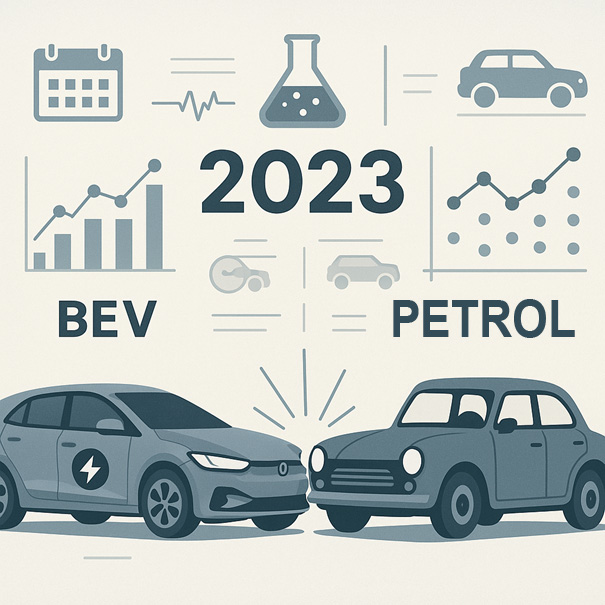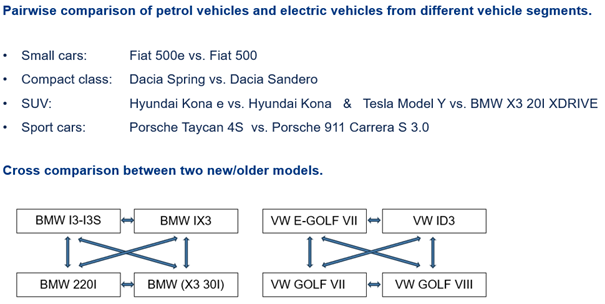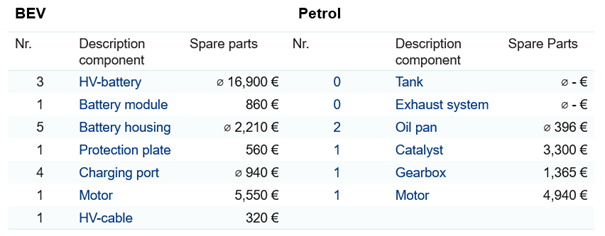Topics at the Allianz Center for Technology:
Influence of electromobility and driver assistance systems on motor insurance claims

(Source: Copilot)
Juli 2025
The study analysed fully comprehensive collision claims from Allianz Versicherungs AG from the year 2023 and compared 450 claims from purely electric vehicles (BEV) with 450 claims from petrol cars.
In order to neutralise systemic effects such as vehicle age and vehicle segment, specific vehicle pairs defined by the GDV with conventional and purely electric drive systems were selected and compared with each other. Where possible, older and newer models were also included in order to take account of the further development and wider distribution of assistance systems.

System and vehicle models analysed
The study shows that electric vehicles have higher labour and spare parts costs compared to petrol vehicles, while the painting costs are comparable. A key driver of the higher labour costs for BEVs is the choice of workshop. Electric vehicles are repaired at authorised workshops in 58% of claims, while petrol vehicles are only repaired there in 48% of cases. On the other hand, 32% of electric vehicles go to independent workshops - less often than petrol vehicles (48%). This is relevant because authorised workshops charge around 50% higher hourly rates than independent workshops for the investigated claims, regardless of the drive technology.
An analysis of the higher spare parts costs for electric vehicles shows that the main influencing factor is the replacement of high-voltage (HV) components - especially the traction battery. For BEVs, HV components account for 7% of total spare parts costs, but for some models this figure can be as high as 20%. As part of the study, comparable drive components such as the catalytic converter and fuel tank were defined for petrol vehicles to improve comparability. However, these only accounted for 1% of the total replacement part costs.

Damaged drive components
The high costs for HV components are primarily driven by the high-voltage battery, which is very rarely damaged but can cause very high costs in the event of damage.
Driver assistance systems also contribute significantly to the cost of spare parts for electric vehicles. ADAS sensors account for 5% of spare parts costs for BEVs, compared to 3% for petrol vehicles. In the case of electric vehicles, at least one ADAS sensor is replaced in 15 % of the claims. The very expensive front radar sensors in particular are replaced more than twice as often in electric vehicles as in petrol cars. However, there are also major differences between the individual models. Depending on the vehicle model, a front radar sensor can cost between €300 and €3,000.
At the same time, driver assistance systems can successfully prevent accidents. Due to the number of claims analysed and the large number of vehicle models, it is not possible to make clear statements for all assistance systems. However, a trend towards less serious damage in newer, better-equipped vehicles can be identified. This can be seen most clearly with the front emergency braking assist, which clearly leads to fewer rear-end collisions, especially in direct comparison.
LED headlights are another major cost driver. Headlights account for 7% of the spare parts costs for both vehicle types, which is higher than the proportion accounted for by ADAS sensors. At an average of €1,250 for a headlight, LED headlights are significantly more expensive than halogen headlights at €280.
To summarise, it can be said that the choice of workshop and rare but expensive damage to the high-voltage battery are the main reasons for the higher damage costs for electric vehicles.
At the same time, it is becoming increasingly difficult to make generalised statements about electric vehicles as product diversity increases. In future, a detailed analysis at model level will be necessary.
The increasing spread of driver assistance systems and LED headlights will cause spare parts costs to rise further, regardless of the type of drive, although ADAS can also effectively prevent accidents. These findings will help both the AZT and the GDV to better assess future developments in the area of motor vehicle claims.